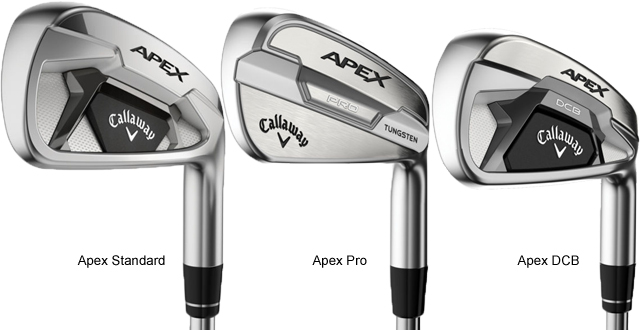 The Apex 21 update of the popular iron family takes advantage of Callaway Golf’s A.I.-design capability and adds the game-improvement DCB to the Standard and Pro models.
The Apex 21 update of the popular iron family takes advantage of Callaway Golf’s A.I.-design capability and adds the game-improvement DCB to the Standard and Pro models.
Fast Facts:
Apex 21 Irons
Players-distance category iron
Forged 1025 mild carbon steel construction
A.I.-designed face cup
Tungsten weighting
Urethane microspheres
5-iron loft 23.5°, pitching wedge loft 43°
Stock shafts: Elevate ETS 95, Recoil Dart 75
Stock grip: Golf Pride Z
Available Feb.11
$185 each steel shafts, $200 graphite shafts
Apex Pro 21 Irons
Players category iron
Forged hollow body construction
A.I.-designed face cup low and mid lofts
Tungsten weighting
Urethane microspheres
5-iron loft 26°, pitching wedge loft 45°
Stock shafts: Elevate ETS 115, Mitsubishi MMT
Stock grip: Golf Pride Z
Available Feb.11
$185 each steel shafts, $200 graphite shafts
Apex DCB Irons
Game-improvement category iron
Forged cavity back construction
A.I.-designed face cup
Tungsten weighting
Urethane microspheres
5-iron loft 23°, pitching wedge loft 43°
Stock shafts: Elevate ETS 85, Recoil Dart 65
Stock grip: Golf Pride Z Soft
Available Feb.11
$185 each steel shafts, $200 graphite shafts
WYNTK:
The popularity of the previous Apex irons offered two years ago prompted Callaway Golf to update the family and include in addition to the Standard and Pro models, a new game-improvement iron under the tag DCB.
Each of the three versions take advantage of a face cup, Callaway’s Flash Face, which was designed using their supercomputer and artificial-intelligence software. In addition to improving the spin characteristics across the entire face, from heel to toe and bottom to top, A.I. allowed individual lofts to each have their own configuration with the goal of maximizing ball speeds for more distance.
The flagship of the family is the Apex 21 with what the marketing department calls a “21st century forging” and though categorized as a players-distance iron, they should be playable by a wide range of handicaps. The internal Tungsten Energy Core of up to 64 grams runs across the bottom and is split between the toe, middle and heel. This is five times the amount of the corresponding Apex 19 loft iron and serves to improve launch plus provide more forgiveness when impact is not in the center of the face. The now familiar urethane microspheres are also inside to absorb vibration which improves the iron’s feel plus the sole’s leading edge was reshaped for less turf drag.
Apex Pro 21 players-category irons are for those scratch and single digit golfers looking for more distance and spin control while also getting a somewhat easier to hit iron rather than a pure blade. The construction is a hollow body that uses the A.I. Flash Face Cup in the 3- through 7-iron and a face plate in the 8-iron through A-wedge. As with the Apex 21s the Pro model has tungsten weighting varying by loft, for example 90 grams in the 7-iron, plus makes use of the urethane microspheres. Callaway is quick to point out combo sets of the Standard and Pro make a lot of sense and in fact a stock combo set is available (Standard 3 through 7 and Pro 8 through A wedge) though any combination is available.
The newbie of the family is the game-improvement Apex DCB (Deep Cavity Back) with a lot more offset than the Standards, a distinctly wider sole and a relatively deep cavity back that pushes weight out towards the perimeter. DCBs are targeted for use by those wanting a forged iron but needing more help launching the ball properly. Not meant to be a direct competitor to Callaway’s Big Bertha cast irons released earlier, the DCBs are a good alternative for higher handicappers wanting to play a forged iron. Mixed or combo sets are also a good possibility using the DCB’s for the lower lofts rather than hybrids.
